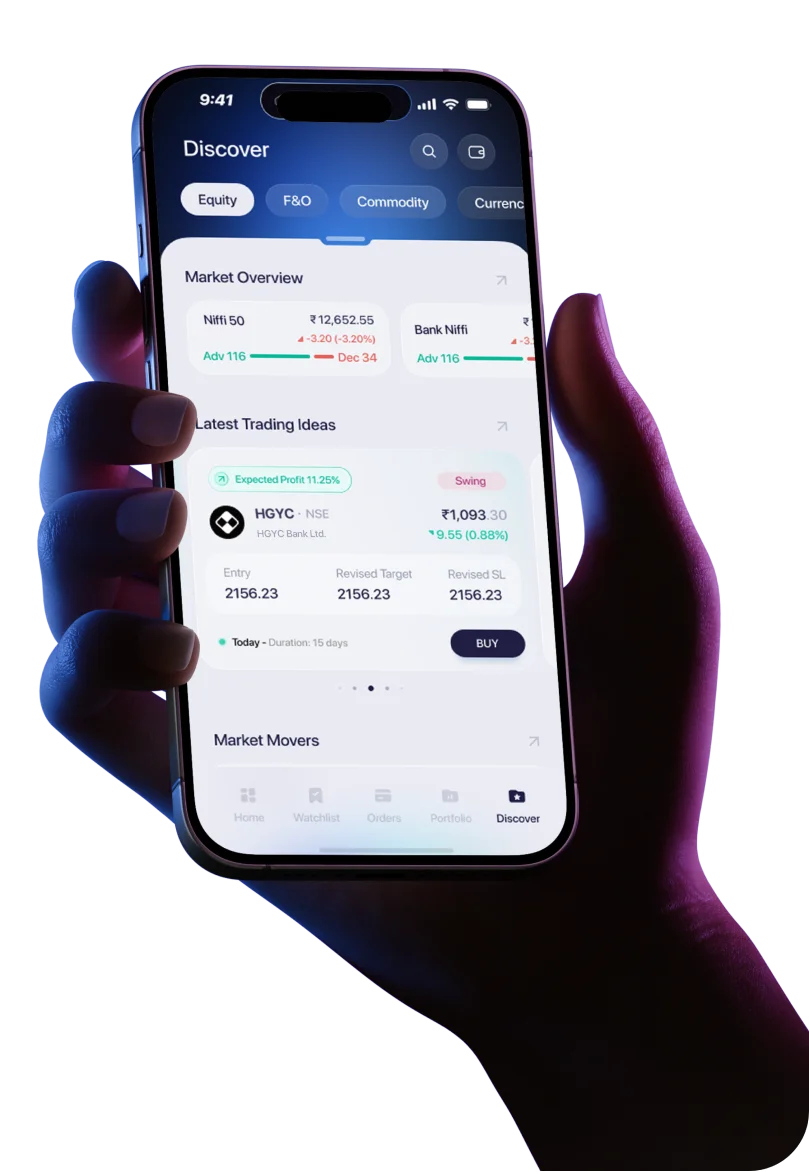In this article, we will discuss
- The Elliott Wave Theory: An Overview
- The 5-3 Wave Pattern in the Elliott Wave Theory
- Decoding Impulse Waves in the Elliott Wave Theory
- Decoding Corrective Waves in the Elliott Wave Theory
- Fibonacci Ratios and the Elliott Wave Theory
- Trading Opportunities Using Elliott Waves
- Conclusion
Market psychology plays a crucial role in determining the price movements of stocks and securities. However, it is rarely easy to predict how investors think and react to different events and developments. At best, you can make an educated guess about how the market may move in the next few hours, days or weeks.
To make this educated estimation, you need to rely on various tools like technical analysis and price indicators. Additionally, the Elliott Wave Theory can be crucial in assessing market trends and turning points. Let us explore what this theory proposes and how indicators based on this theory can help decode market psychology.
The Elliott Wave Theory: An Overview
The Elliott Wave Theory essentially proposes that the market moves in two phases: a motive or impulse phase followed by a corrective phase. This is because investors tend to oscillate between feeling optimistic and then pessimistic about the markets in turn. The optimistic phase leads to motive or impulse waves, while the pessimistic phase is characterised by corrective waves.
This theory was originally developed in the 1930s by Ralph Nelson Elliott, an American accountant who studied price movement data gathered from around 75 years. His analysis relied on charts of varying timeframes like 30-minute, hourly, daily, weekly, monthly and yearly charts.
Elliott made history when he used his theory to predict a stock market bottom with a high degree of accuracy in 1935. Since then, investors and traders have relied on the Elliott Wave Theory in combination with various technical analysis indicators to assess how the price of a stock or security may move.
The 5-3 Wave Pattern in the Elliott Wave Theory
According to the Elliott Wave Theory, the market is influenced by investor sentiment or mood swings. These moods are best represented by a 5-3 wave pattern that represents a trend and a trend reversal.
The five waves that move the market in the direction of the current trend are collectively known as the motive or impulse waves. This is because they represent the prevailing motive or impulse in the market. This phase is generally followed by a set of three waves that reverse the prevailing trend, leading to a corrective phase. So, the three waves in this phase are called corrective waves.
Both impulse and corrective waves follow a fractal pattern where they may be nested within a larger wave. This means that the near-term trend over a few weeks may be bullish, characterised by strong impulse waves that drive the price upward. However, these impulse waves may be nested within a larger corrective wave, which represents a long-term bearish trend. This effectively means that your short-term outlook should be bullish, but your long-term outlook should account for a falling market.
Decoding Impulse Waves in the Elliott Wave Theory
The impulse waves or motive waves in the market include five sub-waves numbered from 1 to 5. The overall direction of movement of these five waves is the same as the direction of the broad trend prevailing in the market. Impulse waves can move the market upward (in a bullish phase) or downward (in a bearish phase).
To understand these wave patterns better, let us consider a bullish market where the motive waves move the market upward. Check out the image below, where the five waves numbered from 1 to 5 and marked in green represent the impulse waves.
As you can see, Wave 1, Wave 3 and Wave 5 represent the prevailing trend, while Wave 2 and Wave 4 represent minor corrections within the impulse phase. Here is how these waves can be studied and interpreted.
Wave 1:
This wave marks the beginning of the impulse phase, where the market begins to move upward (or down in a bearish impulse wave pattern). Here, buyers are gaining momentum and the prices show a slight uptick.
Wave 2:
This is a minor corrective wave where the prices reverse by a small margin. The end of Wave 2 can never be the same or go past the beginning of Wave 1. In other words, the correction is always less than the initial momentum.
Wave 3:
Wave 3 is the strongest and the longest motive wave in the impulse wave pattern. It is typically characterised by high trading volumes as the buyers gain the upper hand in the market. This wave takes the market further in the ongoing direction.
Wave 4:
Wave 4 is another corrective wave in the impulse wave pattern. The end of Wave 4 must never overlap with the end of Wave 1. This essentially means that the second correction is not strong enough to pull the price lower than the previous correction.
Wave 5:
Wave 5 is the last one in the motive wave pattern. It further pushes the market upward, in the direction of the prevailing trend. However, this wave is also shorter than Wave 3. After this push, the phase of the corrective waves begins.
Decoding Corrective Waves in the Elliott Wave Theory
According to the Elliott Wave Theory, there are three sub-waves in the corrective phase. These corrective waves are labelled as A, B and C. Let us examine what these waves represent in a bullish market followed by a bearish correction, as shown in the image below.
As you can see, Wave A and Wave C represent a correction or reversal of the prevailing trend, while Wave B represents a minor push in the upward direction within the corrective phase. Let us study these waves further.
Wave A:
This corrective wave represents the start of the trend reversal. As the image shows, the price falls below the highest point of Wave 5.
Wave B:
Wave B represents a small reversal within the corrective phase. It is typically quite minor and the peak of Wave B is always less than the peak of Wave 5.
Wave C:
This corrective wave is the final push in the direction of the counter-trend. The strength of the move in this wave depends on the selling pressure in the market.
Note: The Elliott Wave Theory also applies to bearish markets followed by a bullish correction. In that case, the impulse waves pull the market down while the corrective waves push the prices up. The image below represents the motive and corrective waves in a bearish-bullish scenario.
Fibonacci Ratios and the Elliott Wave Theory
A Fibonacci sequence is a series of numbers — where each number is the sum of the two numbers preceding it. For instance, this string of numbers is a Fibonacci sequence: 0, 1, 1, 2, 3, 5, 8, 13, 21, 34, 55, 89, 144, 233 and so on till infinity.
Fibonacci ratios are exclusive percentages that are obtained by dividing the numbers in a Fibonacci series in a specific manner. Some key Fibonacci ratios include the following:
- 61.8%, which is the ratio of a number and the one that follows it
- 38.2%, which is the ratio of a number and the number two spots after it
- 23.6%, which is the ratio of a number and the number three spots after it
The Elliott Wave Theory is closely linked to many key Fibonacci ratios. Here are some key findings that Elliott put forward regarding the impulse and corrective waves in the market and Fibonacci ratios.
- Wave 2 may retrace 85.4%, 76.4%, 61.8% or 50% of Wave 1
- Wave 3, being the longest impulse wave, is often 161.8% of Wave 1
- Wave 4 often retraces 38.2%, 23.6% or 14.6% of Wave 3
- Wave 5 may be equal to Wave 1 or 123.6% to 161.8% of Wave 4
Trading Opportunities Using Elliott Waves
The Elliott Wave Theory presents various trading opportunities if you know how to interpret the different historical wave patterns and use the past data to anticipate future market movements. Here is how you can use this theory to find trading opportunities.
Entry Points:
You may choose to enter a position at the end of Wave 2, Wave 4 or Wave B. In an upward-trending impulse phase, the end of Wave 2 or Wave 4 may be ideal to enter a long position and the end of Wave B may be suitable for taking a short position. It is the opposite in the case of a downward-trending impulse phase.
Stop-Loss Limits:
Your stop-loss limit depends on the point at which you enter the market. If you enter at the end of Wave 2, your stop-loss limit should be the ending price of Wave 2. If you enter at the end of Wave 4, you can set the stop-loss price at the ending point of Wave 4. Similarly, if you enter the market at the end of Wave B, its ending price may be the ideal stop-loss limit.
Target Price:
It is best to set the anticipated ending points of Wave 3 or Wave 5 as the target prices. You can use Fibonacci ratios to get a better idea of what these price points may be.
Conclusion
Now that you know what the Elliott Wave Theory is and how you can use it to predict price wave patterns, you can strategise your trades better. That said, you cannot rely on tracking impulse and corrective waves alone. You also need to perform in-depth technical analysis and ensure that you capitalise on market opportunities before they pass.
Samco’s trading app can be instrumental in this regard. With a comprehensive range of technical indicators and analytical tools available at your fingertips, you can quickly analyse the current market conditions and make timely trade decisions — so you never miss out on any trading opportunity.
Want to access the Samco trading app free of cost and benefit from the plethora of trading tools it offers free of cost? All you need to do is open a demat account and trading account with Samco Securities today.
Disclaimer: INVESTMENT IN SECURITIES MARKET ARE SUBJECT TO MARKET RISKS, READ ALL THE RELATED DOCUMENTS CAREFULLY BEFORE INVESTING. The asset classes and securities quoted in the film are exemplary and are not recommendatory. SAMCO Securities Limited (Formerly known as Samruddhi Stock Brokers Limited): BSE: 935 | NSE: 12135 | MSEI- 31600 | SEBI Reg. No.: INZ000002535 | AMFI Reg. No. 120121 | Depository Participant: CDSL: IN-DP-CDSL-443-2008 CIN No.: U67120MH2004PLC146183 | SAMCO Commodities Limited (Formerly known as Samruddhi Tradecom India Limited) | MCX- 55190 | SEBI Reg. No.: INZ000013932 Registered Address: Samco Securities Limited, 1004 - A, 10th Floor, Naman Midtown - A Wing, Senapati Bapat Marg, Prabhadevi, Mumbai - 400 013, Maharashtra, India. For any complaints Email - grievances@samco.in Research Analysts -SEBI Reg.No.-INHO0O0005847







 Easy & quick
Easy & quick
Leave A Comment?